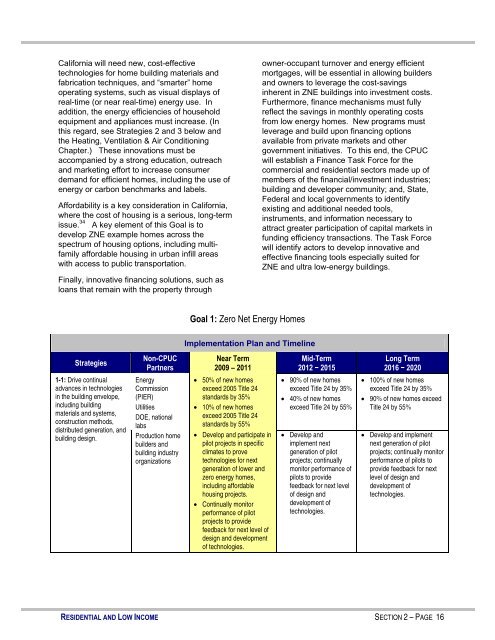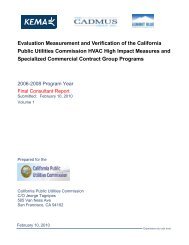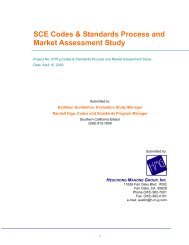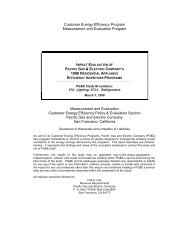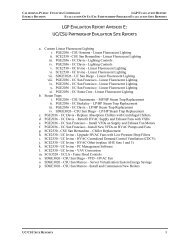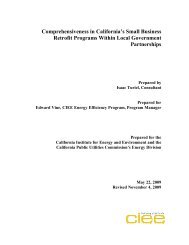Long Term Energy Efficiency Strategic Plan - California Public ...
Long Term Energy Efficiency Strategic Plan - California Public ...
Long Term Energy Efficiency Strategic Plan - California Public ...
You also want an ePaper? Increase the reach of your titles
YUMPU automatically turns print PDFs into web optimized ePapers that Google loves.
<strong>California</strong> will need new, cost-effective<br />
technologies for home building materials and<br />
fabrication techniques, and “smarter” home<br />
operating systems, such as visual displays of<br />
real-time (or near real-time) energy use. In<br />
addition, the energy efficiencies of household<br />
equipment and appliances must increase. (In<br />
this regard, see Strategies 2 and 3 below and<br />
the Heating, Ventilation & Air Conditioning<br />
Chapter.) These innovations must be<br />
accompanied by a strong education, outreach<br />
and marketing effort to increase consumer<br />
demand for efficient homes, including the use of<br />
energy or carbon benchmarks and labels.<br />
Affordability is a key consideration in <strong>California</strong>,<br />
where the cost of housing is a serious, long-term<br />
issue. 34 A key element of this Goal is to<br />
develop ZNE example homes across the<br />
spectrum of housing options, including multifamily<br />
affordable housing in urban infill areas<br />
with access to public transportation.<br />
Finally, innovative financing solutions, such as<br />
loans that remain with the property through<br />
owner-occupant turnover and energy efficient<br />
mortgages, will be essential in allowing builders<br />
and owners to leverage the cost-savings<br />
inherent in ZNE buildings into investment costs.<br />
Furthermore, finance mechanisms must fully<br />
reflect the savings in monthly operating costs<br />
from low energy homes. New programs must<br />
leverage and build upon financing options<br />
available from private markets and other<br />
government initiatives. To this end, the CPUC<br />
will establish a Finance Task Force for the<br />
commercial and residential sectors made up of<br />
members of the financial/investment industries;<br />
building and developer community; and, State,<br />
Federal and local governments to identify<br />
existing and additional needed tools,<br />
instruments, and information necessary to<br />
attract greater participation of capital markets in<br />
funding efficiency transactions. The Task Force<br />
will identify actors to develop innovative and<br />
effective financing tools especially suited for<br />
ZNE and ultra low-energy buildings.<br />
Goal 1: Zero Net <strong>Energy</strong> Homes<br />
Implementation <strong>Plan</strong> and Timeline<br />
Strategies<br />
1-1: Drive continual<br />
advances in technologies<br />
in the building envelope,<br />
including building<br />
materials and systems,<br />
construction methods,<br />
distributed generation, and<br />
building design.<br />
Non-CPUC<br />
Partners<br />
<strong>Energy</strong><br />
Commission<br />
(PIER)<br />
Utilities<br />
DOE, national<br />
labs<br />
Production home<br />
builders and<br />
building industry<br />
organizations<br />
Near <strong>Term</strong><br />
2009 – 2011<br />
• 50% of new homes<br />
exceed 2005 Title 24<br />
standards by 35%<br />
• 10% of new homes<br />
exceed 2005 Title 24<br />
standards by 55%<br />
• Develop and participate in<br />
pilot projects in specific<br />
climates to prove<br />
technologies for next<br />
generation of lower and<br />
zero energy homes,<br />
including affordable<br />
housing projects.<br />
• Continually monitor<br />
performance of pilot<br />
projects to provide<br />
feedback for next level of<br />
design and development<br />
of technologies.<br />
Mid-<strong>Term</strong><br />
2012 − 2015<br />
• 90% of new homes<br />
exceed Title 24 by 35%<br />
• 40% of new homes<br />
exceed Title 24 by 55%<br />
• Develop and<br />
implement next<br />
generation of pilot<br />
projects; continually<br />
monitor performance of<br />
pilots to provide<br />
feedback for next level<br />
of design and<br />
development of<br />
technologies.<br />
<strong>Long</strong> <strong>Term</strong><br />
2016 − 2020<br />
• 100% of new homes<br />
exceed Title 24 by 35%<br />
• 90% of new homes exceed<br />
Title 24 by 55%<br />
• Develop and implement<br />
next generation of pilot<br />
projects; continually monitor<br />
performance of pilots to<br />
provide feedback for next<br />
level of design and<br />
development of<br />
technologies.<br />
RESIDENTIAL AND LOW INCOME SECTION 2 – PAGE 16


